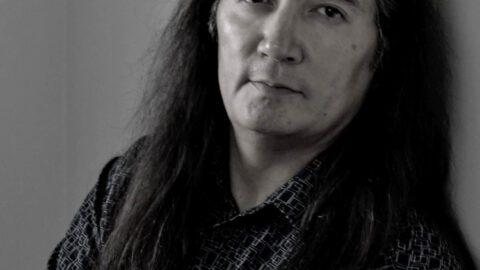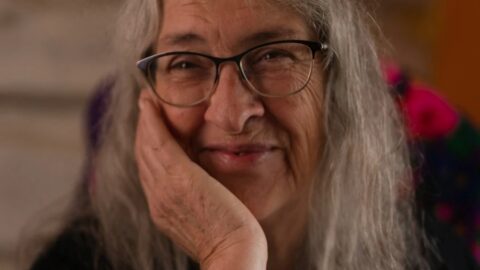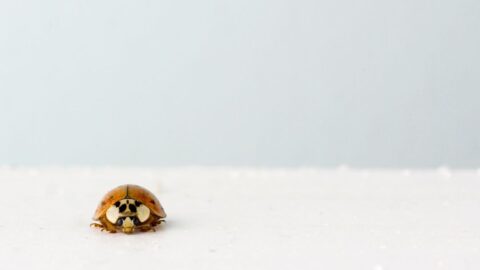Photo Credit: Carole Lyne Robin
BIG Small Talk with Co-Conspirator: Dayna Danger
BIG small Talk is a chance to meet, introduce, and get to know artists that Harbour Collective encounters along the way. Sasha Kucas speaks with Dayna Danger on a Saturday morning for an entertaining discussion full of laughter and BIG small Talk.
Prairie-born and playful in their approach to art and life, do not let this lively and humorous Two-Spirit artist and photographer fool you. They are very interested in sustainability and consciously think about what they are leaving behind as an artist for other people.
Our conversation flowed from topic to topic, leaving several provocatively profound questions in its wake. I could have spoken with them for the whole day. The following is but a small sampling of what they shared with me.
Tell me about your connection to Harbour Collective.
My connection to Harbour Collective is through the Indigenous Arts scene. I first did the COASTLINE NFT workshop, followed by the DOCKED film festival, but I have known Liz Barron in the community for a while.
Congratulations! The new website looks great!
What are you working on right now?
I am working on my fifth or sixth mask for the Kinship Masks series. It’s called the Grandmother Mask and is for all my matriarchs. It acknowledges all feminine spirits and represents all the women I have met from the Metis side of the family. These women taught me the most about my bodily sovereignty and my sexuality in a positive way. I make masks for people; some honoured with the Grandmother Mask do not exist on this plane and are now ancestors, which feels strange. I am using this fetish gimp mask to examine my thoughts and provide the education I wish I had through open dialogue. Grandmother Mask is a BDSM fetish mask for that reason. I am also working towards a PhD. It is my main focus right now and aligns with my work.
What medium do you love to work with and why?
I believe in a pluralist truth.
Photography will always be my favourite medium because it is ready to go and versatile when conveying a vision. I can communicate complex ideas through built realities that reflect the environment and world. Photoshop and other applications could make your realities, but what I like about photography is the almost deception of it all. Images hold potent symbolism. Lens-based people have multiple ways of seeing while behind the camera. I think of Henri Cartier-Bresson and how he was always on the go and good at capturing serendipitous moments, always thinking of time, place, and framing. The photographic process forces us to slow down and think about the frame, especially film. If I am honest, that is my favourite medium. You only have so many shots, and with the expense, what I want to convey and image certainty is a must. I like the precision of analog technologies and the many different ways of expressing pluralistic truths.
How do you approach your art practice?
Usually, my approach stems from an idea developed from a joke shared amongst friends. Jokes give us the ability to talk about difficult things. It is the reason why dark humour exists. When thinking about the Kinship Masks, beautiful beadwork on a gimp suit is an interesting juxtaposition. I am also interested in the underdogs of oppression, politics, and their unheard voices. It parallels my sexual presentation and where I see empowerment. We live in a dominant male gaze society. Even if it gives me great fuel, I am not responding to that; I make work for other people like me. My practice comes from the funny, joyful, laughing place; my politics come in afterward. I start researching. The theory of refusal applies to the Kinship Masks. The masks prevent body consumption; it is a barrier. For me, sex is an enticing way of ultimately talking about consent and the kind of safety parameters that I would have always wanted as a young person or even NOW. Consent does not stop at any age. It will always be on the table. If more Elders talked about consent, I am sure that we would be in a different situation today. How do we educate individuals while they still have hope and joy while dealing with oppressions and intersections? Gender, race, and class meet at the intersection. The people and thinkers that I cite in my work are Indigenous or Black academics such as Kimberlé Crenshaw. She speaks from the perspective of a black woman on intersectionality and how it affects everything. It is the other narrative that challenges the Western conceptualization of thought.
What inspires or motivates you?
The voyeur. The people. Who else would I do this for? Would I do this if nobody could ever look at it? My motivation comes from the tension between comfort and discomfort, of putting yourself out there and then seeing; that is why I do it partly. I am not an exhibitionist by any means; I am a voyeur, and I also like people looking at my stuff while I look at them. There is always this mirroring constantly happening in my work. People react to my work that deals with racier, almost pornographic themes; it is the bait and done on purpose. I like putting them in my world. Once there, whatever they see is up to them. Also, the community and Two-Spirit people inspire me because we were never supposed to survive and exist as we are today. OMG, and my Two-Spirit Elders! They inspire me because they live unapologetically as themselves and make it so that I can be here today. They survived in a time when it was uncool to be queer and with minimal rights. I honour their journeys and think about the community. I make this work so that there is some visual, erotic history. Historically, it was dangerous to record or be visible. However, I find that the Anishinaabe people always had an integrated queer understanding and approach where the feminine voice held importance.
From what you have created, what is your most meaningful piece?
My most meaningful piece is the 17-minute video Bebeschwendaam, which I made with my friend Parneet. I feel the same vulnerability, exposure, and catharsis as the people in my work when I place myself in front of the camera. I stand by my work. In this video, we try to get close to each other while wearing moose antlers attached to harnesses. While porn is well-edited with a linear narrative, Bebeschwendaam breaks the narrative by being fun, dangerous, and with multiple climaxes. We push our boundaries to see how we connect while being aggressive and oscillate between intimate, quiet moments. It was kind of like a BDSM scene when we negotiated what we were going to do. You can hear us talking, giggling, and asking for consent; that was important. The video has layers and not just women-for-women porn. It is just hot and with no actual sex happening.
What do you value most in life?
My cats. Just kidding. Love is the thing that I value most in life. You can have so many different ways to have love. I am not just thinking of romantic love. I think about romantic love- but I realize you can have it with your friends or yourself. I want to start talking about it in a way that is real. In a world with so much scarcity, the generative abundance-making of love is not necessarily cheesy. Love is one of the most important things. When I am in my darkest moments, I find hope. Hope and love for me are intrinsically tied together. People can lose everything, and when you feel that, what happens after that? Love.
What gets you out of bed in the morning?
COFFEEEEEEEEEEE hahahahahaha
If you could possess a superpower, what would it be and why?
What Mystique does as a chameleon is what I would possess. I like the idea of being something, being able to watch or see something that you would not usually. My superpower would be my ability to shape-shift.
That makes total sense as an extension of voyeurism.
Right? HAHAHAHAHA! You are learning a lot! HAHAHA!
What would you do if you won 30 million dollars?
I would try to buy as much of Canada as I can back!
What is the worst-smelling place you have ever been to?
New York stinks. It smells like pee all the time, everywhere, and if it is a hot day in New York and a garbage day? No, like no -sorry, New York.
If you see Danger, they might be on their way to their cool time-machine cave of a studio where there is no time or sun, probably petting cats and maybe looking for real food like Romados Portuguese chicken or spaghetti. They might be heading towards Concordia University to teach the next generation about Sexual Representation in the Arts.
Whatever you do or say, invite them for a – “girl dinner, aka a Montreal dinner.” If you don’t know what that is, no worries, they will tell you happily. Do exchange sexual awakening stories, laugh together, play Egyptian Ratscrew, and ask them about what theorist they are reading before hitting the sheets.
The song “What Does the Fox Say?” has a new meaning now. We are so glad you never became a veterinarian with eight children.
Dayna Danger (they/them) is a Two-Spirit, Indigiqueer, Métis-Saulteaux-Polish, visual artist, hide tanner, drummer, and beadworker. Danger’s art practice is an act of reclaiming space and power over society’s projections of sexualities and representation. This transpires in Danger’s art by their intentionally large-scale images that place importance on women-identified, Two-Spirit, transgender, and non-binary people. Their art uses symbolic references to kink communities to critically interrogate visibility and rejection. Danger centers Kin and practicing consent to build artworks that create a suspension of reality wherein complex dynamics of sexuality, gender, and power are exchanged.













